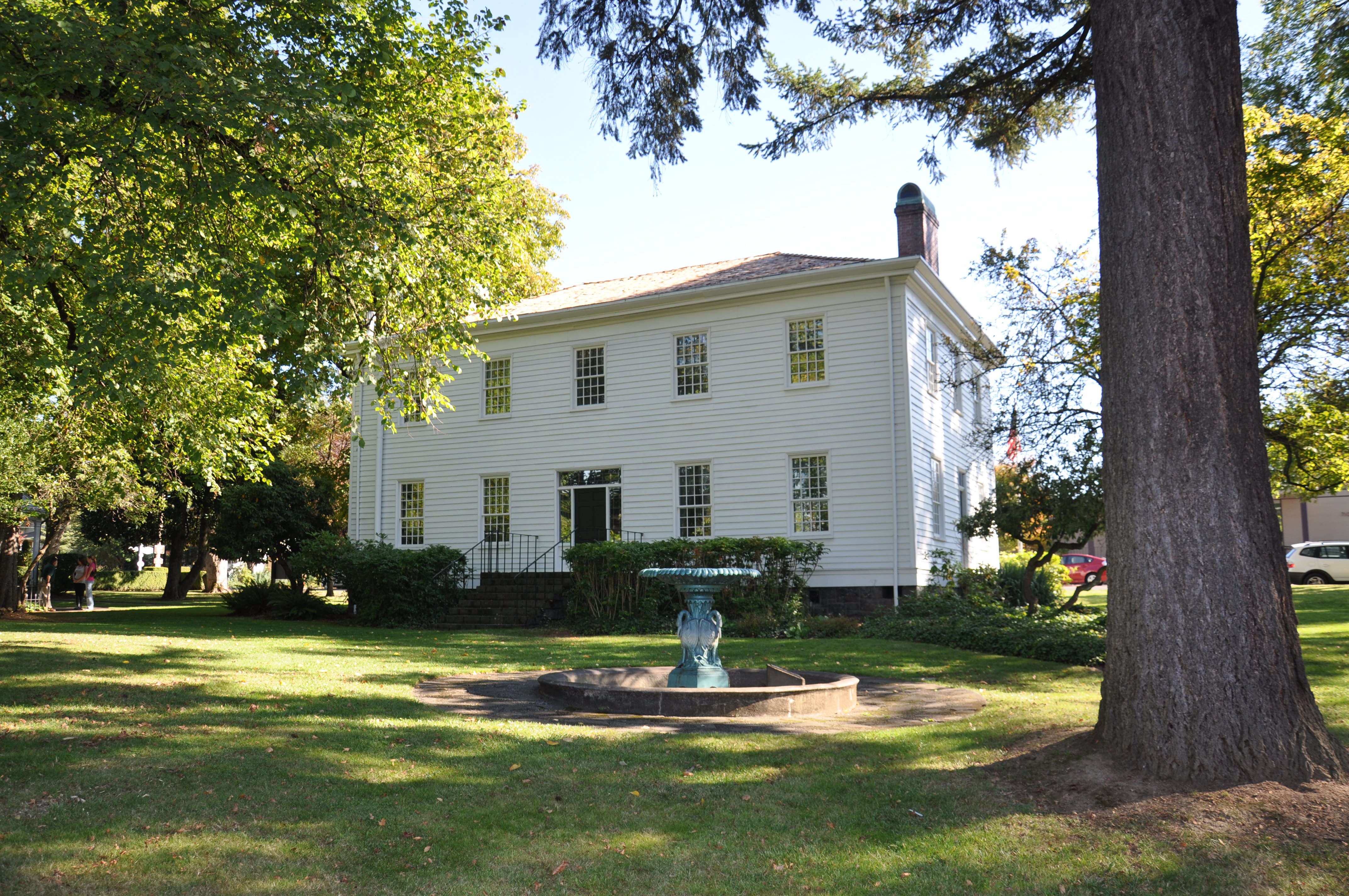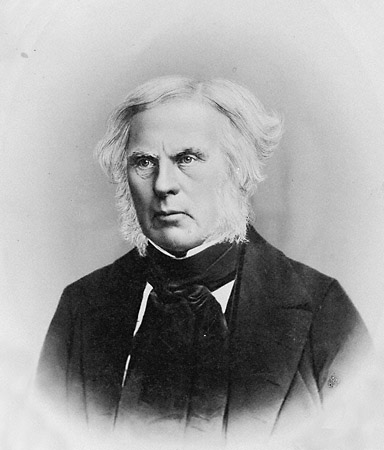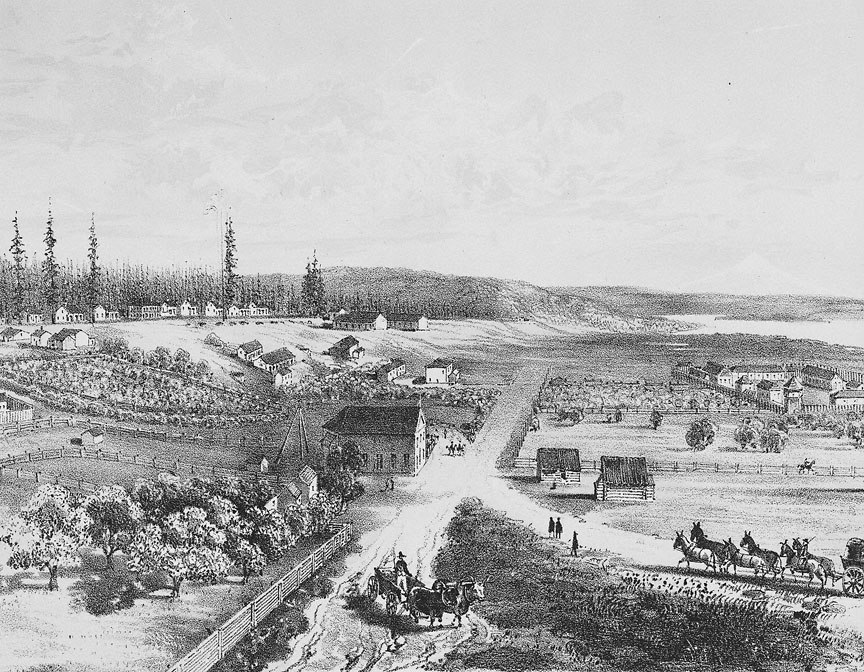One of the grandest and most elaborate homes in Oregon when it was built in 1846, the McLoughlin House in Oregon City was home to Dr. John McLoughlin after his retirement as chief factor overseeing Hudson’s Bay Company operations in the northwest from Fort Vancouver. Efforts to save the McLoughlin House, which is now a unit of the National Park system, helped pioneer the historic preservation movement in Oregon and the western United States.
McLoughlin’s large, extended family lived in the house, including McLoughlin’s wife Marguerite, his widowed daughter Eloisa and her three children, Marguerite’s granddaughter Catherine Ermatinger and her daughter, and, for a time, Marguerite’s grandson William McKay. After Eloisa’s marriage to William Harvey, he, too, moved in—and, eventually, the couple’s three children—as did McLoughlin’s son David.
With its hipped roof, flanking interior end-wall chimneys, clapboard siding, and symmetrical double-hung windows, the two-story wood-framed building presented a commanding presence in Oregon City. Its interior design reflected a variation of the symmetrical Georgian central-hall plan, with a large central hall and smaller back rooms adjacent to the parlor and dining room on the first floor and another large central hall and four large bedrooms on the second.
The house was well suited for family life. George L. Boone, grandson of Daniel Boone, recalled that William McKay “often asked me to stay all night with him. Plenty of beds upstairs at the McLoughlin House.” Following McLoughlin’s death in 1857, members of the family continued to live in the house until 1867, when the Harvey family relocated to Portland.
Before long, the building became a boarding house. With a new two-story addition, the Oregon City Spectator billed the house as “the most commodious Hotel in the city.” The Harveys sold the building in 1873. Known for a time as the Phoenix Hotel, it served as a laundry and tenement by the late 1880s. By the turn of the twentieth century, the building had fallen into disrepair and was partially vacant.
The Hawley Pulp and Paper Company purchased the building in 1908 and eventually donated the house to the city. After Governor George E. Chamberlain vetoed a bill that would have preserved the building, Oregon City councilmen prohibited the use of taxpayer dollars to preserve or relocate the house and announced that the building would be demolished on April 23, 1909.
Those actions sparked one of the Pacific Northwest’s first historic preservation efforts. Eva Emery Dye, a popular writer and advocate, was one of several public figures to use their extensive networks to save the house. She mobilized members of the Woman’s Club of the Lewis and Clark Exposition and joined prominent citizens and politicians to form the McLoughlin Memorial Association (MMA) in an attempt to preserve and restore the building.
There was opposition to the effort from the start. Calling the building “an old, unsightly, unsanitary and dilapidated building” and a “haunt of shame and disgrace . . . used for vile purposes so long that no decent, purity loving citizen can associate it with any good purpose,” critics feared that it would “disgrace a park block and destroy the most beautiful park site in our city.” They warned that retaining the building would lower property values and impinge on citizens’ right to enjoy the public square. Privately, other issues seemed to underlie the opposition. As one advocate wrote, “Ignorance and bigotry have been conspicuous in a futile attempt to prevent the restoration of the McLoughlin Home.”
The city council finally donated the house to the MMA and gave permission for it to be placed in the city park on the high bluff overlooking the Willamette River. The site chosen, on Center Street, was part of McLoughlin’s land claim, donated by him to the City of Oregon City in 1850 and platted for use as a municipal park.
After numerous injunctions against the MMA and restraining orders against the contracted movers were either exhausted or resolved, a crew of workers and horses dismantled the chimneys and roof of the building before pulling it up the steep incline of Singer Hill Road and placing it in the park. Photographs show what must have been an amazing sight: a horse, a capstan-like wheel and pulley device, several workers, and the house precariously positioned over the roadway. The MMA spearheaded the restoration of the building as a house museum and led a larger restoration project from 1933 to 1939 that also saw the Barclay House moved to the site.
The McLoughlin House became an affiliated site of the National Park system in 1941, following its designation as the first national historic site in the western United States. It was operated and maintained by the MMA. In 2003, U.S. Congresswoman Darlene Hooley introduced legislation that led to the National Park Service formally making the McLoughlin House a unit of Fort Vancouver National Historic Site. Through this action, the NPS purchased the two houses from the MMA and assumed management of the houses and their associated programs and museum collections.
-
![The restored home of John and Marguerite McLoughlin.]()
McLoughlin House.
The restored home of John and Marguerite McLoughlin. Courtesy National Park Service
-
![John McLoughlin]()
John McLoughlin.
John McLoughlin Courtesy Oreg. Hist. Soc. Research Lib., OrHi067763
Related Entries
-
![Hudson's Bay Company]()
Hudson's Bay Company
Although a late arrival to the Oregon Country fur trade, for nearly two…
-
![John McLoughlin (1784-1857)]()
John McLoughlin (1784-1857)
One of the most powerful and polarizing people in Oregon history, John …
Related Historical Records
Map This on the Oregon History WayFinder
The Oregon History Wayfinder is an interactive map that identifies significant places, people, and events in Oregon history.
Further Reading
Barbaero, Kerry K. Historic Structure Report of the McLoughlin House National Historic Site, Oregon City, OR. M.S. thesis, University of Oregon, June 2003.
Barker, Burt Brown. The Dr. John McLoughlin House: A National Historic Site. Oregon City, Oreg.: McLoughlin Memorial Association, 1949.
Morrison, Dorothy N. Outpost: John McLoughlin and the Far Northwest. Portland: Oregon Historical Society Press, 1999.




